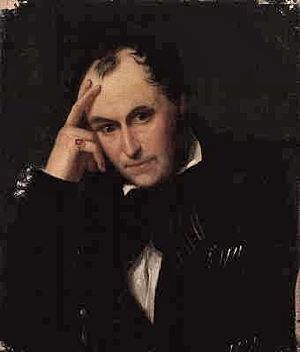
Richard Ford (1796–1858) traveller and author
Page updated 7th January 2014
Return to Exeter People Menu
Richard Ford, the eldest son of Sir Richard and Lady Ford, was born in London on 21 April 1796, and educated at Winchester, and Trinity College, Oxford. In 1824 he married Harriet, only child of the fifth earl of Essex. In 1830 he sailed for southern Spain, hoping that the climate might improve his wife's delicate health. They spent three winters in Seville and the intervening summers in the Alhambra at Granada, before returning to England in the Autumn of 1833.
In the following Spring, having separated from his wife, who died in 1837, he settled at Southernhay, Exeter, near his brother, the Revd James Ford (d. 1877; a prebendary of the cathedral from 1849), later purchasing Heavitree House, which he furnished with the valuable paintings and books acquired in Spain. Ford occupied himself by taking drawing lessons from John Gendall, laying out gardens, erecting a summer-house in a Moresque style, and writing on Spanish subjects, among them, for the Quarterly Review, on the cob walls of Devonshire (1837). It was the first of a series of some fifty substantial articles and reviews which Ford wrote during the next two decades.
In 1838 he married, at Stoke Gabriel, Eliza Linnington (d. 1849), elder daughter of the ninth Lord Cranstoun and, soon after, started on the work by which he is best known, A Hand-Book for Travellers in Spain, eventually published in 1845 by John Murray. Within days, Ford was being lionized as the articulate author of a most comprehensive and accurate account of that country, one unlikely to be ever superseded. As affirmed by Sir William Stirling (later Stirling-Maxwell) in his obituary of Ford, ‘So great a literary achievement had never before been performed under so unpretending an appellation’; it ‘took its place among the best books of travel, humour, and history, social, literary, political, and artistic, in the English language’, and that judgement holds. The influence of this masterpiece, reprinted in 1966, has been profound.
Meanwhile, Ford had been influential in getting George Borrow’s The Zincali and The Bible in Spain published by Murray, while in 1846 appeared his own eminently readable Gatherings from Spain, a series of infomative and entertaining essays. In 1851 Ford married Mary Molesworth (d. 1910), the sister of Sir William Molesworth of Pencarrow, while both Georgina and Mary Jane, daughters from his first marriage, also married, the former to Henry Northcote (Vicar of Monk Okehampton), a son of Sir Stafford Northcote of Upton Pynes. Ford’s only son, Francis Clare, who had a notable diplomatic career, sold Heavitree House in 1898, dying the following year; it was demolished in 1958 and the site built over.
Ford's later years, spent between Exeter (where he had been Vice-President of the Devonshire and Exeter Institution in 1841-42, and later President) and London, were occupied in part with the compilation of the third edition of the Handbook: all later editions were emasculated, and have been compared to ‘Niagara passed through a jelly-bag’. But by then (1855) Ford's eyesight was beginning to fail, and he was suffering from Bright's disease, which was to cause his death on 31 August 1858 at Heavitree, where he was buried in the churchyard of adjacent St Michael’s, his tombstone being fitly inscribed ‘Rerum Hispaniae indagator acerrimus’.
Contributed by Ian Robertson, author of Richard Ford, published by Michael Russell, 2004. Available from Amazon or directly from Graham York, at 225 High Street, Honiton (0140441727)

│ Top of Page │